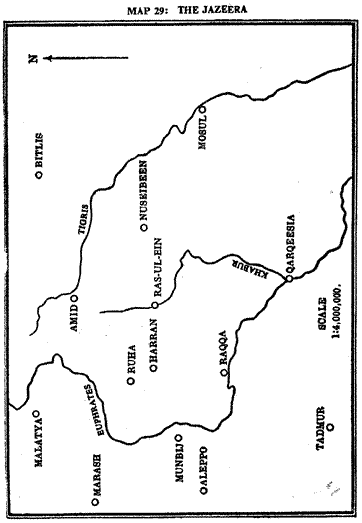|
Following the surrender
of Antioch, Muslim columns moved south along the Mediterranean coast
and captured Latakia, Jabla and Tartus, thus clearing most of North-Western
Syria of the enemy. Abu Ubaidah next returned to Aleppo, and during
this move his columns subdued what remained of Northern Syria. Khalid
took his Mobile Guard on a raid eastwards up to the Euphrates in
the vicinity of Munbij, but found little opposition. In early January,
638, he rejoined Abu Ubaidah at Aleppo.
All of Syria was now in Muslim hands. Abu
Ubaidah left Khalid as commander and administrator at Qinassareen,
and returned with the rest of his army to Emessa, where he assumed
his duties as governor of the province of Emessa, of which Qinassareen
was then part. From Qinassareen Khalid would keep watch over the
northern marches.
By the end of 16 Hijri (corresponding roughly
to 637 A.D.) all Syria and Palestine was in Muslim hands, except
for Caesarea which continued to hold out. The various Muslim commanders
settled down to their duties as governors of provinces: Amr bin
Al Aas in Palestine, Sharhabeel in Jordan, Yazeed in Damascus (but
currently engaged at Caesarea) and Abu Ubaidah in Emessa. Khalid
had a lower appointment as administrator in Qinassareen under Abu
Ubaidah. This state of peace continued for a few months until the
mid-summer of 638, when clouds again darkened the sky over Northern
Syria. This time the Christian Arabs of the Jazeera took to the
warpath.
Heraclius was no longer able to attempt
a military comeback in Syria. In fact he was now more worried about
the rest of his Empire, which, after the destruction of his army
at Yarmuk and Antioch, was extremely vulnerable to Muslim invasion.
He had few military resources left with which to defend his domains
against an army which marched from victory to victory. To gain time
for the preparation of his defences it was essential to keep the
Muslims occupied in Syria, and he did this by inciting the Arabs
of the Jazeera to take the offensive against the Muslims. Bound
to him by ties of religion, they submitted to his exhortations;
and gathering in tens of thousands, began preparations to cross
the Euphrates and invade Northern Syria from the east.
Agents brought Abu Ubaidah information on
the preparations being made in the Jazeera. As the hostile Arabs
began their move, Abu Ubaidah called a council of war to discuss
the situation. Khalid was all for moving out of the cities as one
army and fighting the Christian Arabs in the open, but the other
generals favoured a defensive battle at Emessa. Abu Ubaidah sided
with the majority, and pulled in the Mobile Guard from Qinassareen
and other detachments from places which they had occupied in Northern
Syria. He concentrated his army as Emessa and at the same time informed
Umar of the situation.
Umar had no doubt that Abu Ubaidah and Khalid
would hold their own against the irregular army which now threatened
them; but he nevertheless decided to assist them, and did so in
a most unusual manner. He sent instructions to Sad bin Abi Waqqas,
the Muslim Commander-in-Chief in Iraq, to despatch three columns
into the Jazeera: one under Suheil bin Adi directed at Raqqa, another
under Abdullah bin Utban directed at Nuseibeen and a third under
Ayadh bin Ghanam operating between the first two. (See Map 29 below)
At the same time Umar ordered the despatch of 4,000 men under Qaqa
bin Amr from Iraq to Emessa, along the Euphrates route, to reinforce
Abu Ubaidah.

|
